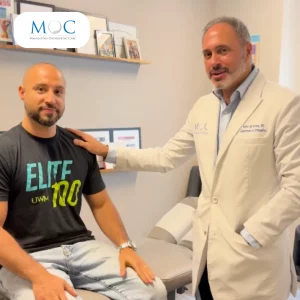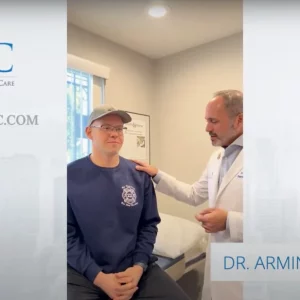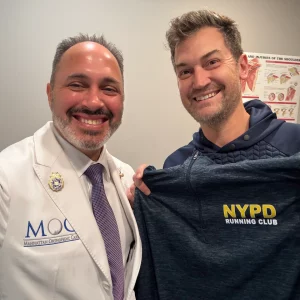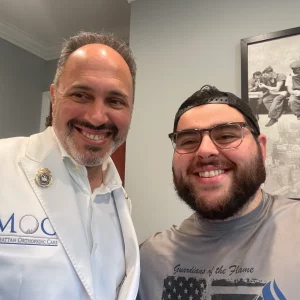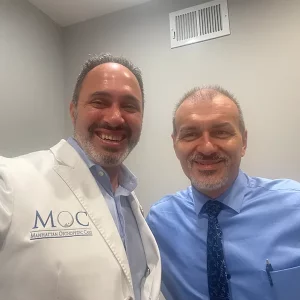Shoulder Subluxation vs. Dislocation: Do You Know The Difference?
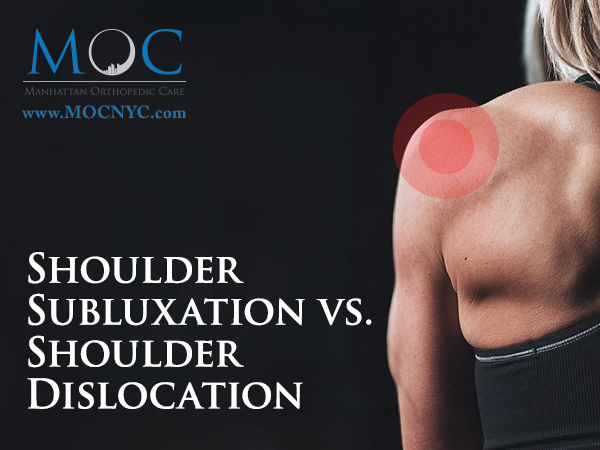
A shoulder injury that forces your joint out of place is not only painful but can also be incredibly disruptive to
your daily life. You’re likely seeking answers and need to know if you’re dealing with a complete shoulder dislocation
or a partial one, known as a subluxation. Knowing the distinction between subluxation vs. dislocation is the vital
first step towards healing, as it directly impacts the type of care you require. Let Dr. Tehrany and the expert team
at Manhattan Orthopedic Care provide the clarity and treatment plan you need to get back on track.
Subluxation vs. Dislocation: Identifying Your Shoulder Injury
The shoulder joint is loosely fixed so you can reach up and catch a ball or grab something off a shelf. This mobility
also makes the shoulder dislocate more often than other similarly designed joints. Picture one of your hands forming
the letter “C.” Now imagine balling up the other hand into a fist and sliding it into the “C.” This is a basic
synovial ball and socket joint like the one that allows you to move your arm.
Medically, the shoulder is the glenohumeral
joint. Your shoulder is where the glenoid fossa, the “C” figure or socket, of the shoulder blade meets the ball
head of the humerus, the large upper bone in your arm. A capsule of connective tissue surrounds the joint, helping
keep the ball securely inside the “C”. Because the shoulder can move in many directions, it has the potential to
dislocate in various ways. Proper joint movement relies on the ball and socket remaining correctly aligned. A
significant impact or force to the shoulder can disrupt this alignment and cause injury. Understanding the difference
in subluxation vs dislocation starts with its anatomy.
What Is a Shoulder Dislocation?
When you have a shoulder dislocation it means the ball and
socket of the joint have fully separated. The ball section of the humerus has detached fully from the glenoid fossa.
This is a common injury because the glenoid fossa, or socket of the joint, is very shallow, allowing the humerus bone
to become loose without much force. The majority of dislocations are anterior, so the ball section of the humerus pulls out of the socket and is
pushed towards the front of the body. This is an injury that can happen when you fall. The natural instinct is to put
your hands out in front of you to try to stop the fall. As you hit the ground, the ball in the shoulder joint pops out
or dislocates, and moves towards the front.
What Is Subluxation of the Shoulder?
A subluxation of the shoulder is
essentially a partial dislocation; the ball and socket are not fully separated. The two structures of the joint are
still in contact, but one has shifted out of alignment. Damage to the supporting architecture, like the muscles or
tendons, can weaken the joint and allow subluxation. For example, when a baseball player suffers an injury to his
rotator cuff it may result in a shoulder subluxation. The rotator cuff is a group of muscles and connective tissue
that holds the joint together. If the muscle tears, the ball of the joint may come loose enough to let the humerus
bone shift out of place while still remaining housed in the glenoid fossa. A dislocation involves the structures of
the shoulder while a subluxation usually is about the mechanical integrity of the shoulder and its supporting
structures.
Key Differences Between Subluxation Versus Dislocation
Although both injuries might seem similar as they affect the shoulder’s ball-and-socket joint, understanding the
distinction between subluxation versus dislocation is key. A subluxation only partially shifts the humeral head out of
place and presents mild symptoms, allowing limited movement. A dislocation involves complete separation and typically
causes severe pain and visible deformity.
Degree of Separation
- Shoulder Subluxation: Partial displacement of the humeral head from the shoulder socket
- Shoulder Dislocation: Complete displacement of the humeral head from the shoulder socket
Causes and Associated Injuries
Shoulder Subluxation
- Minor trauma or repetitive strain (e.g., overuse in sports)
- Lax ligaments or connective tissue disorders
- Muscle weakness or poor posture
- Potential soft tissue strain, nerve pinching, or ligament stretching
Shoulder Dislocation
- Significant trauma (sports injury, fall, car accident)
- Sudden, high-impact force applied to the shoulder joint
- Often accompanied by severe ligament/tendon tears, possible nerve damage, fractures, or labral tears
Symptoms and Visible Signs
Shoulder Subluxation
- Mild to moderate pain and discomfort
- Feeling of looseness, slipping, or instability
- Possible slight swelling or subtle deformity (sometimes hard to detect visually)
Shoulder Dislocation
- Severe pain, often immediate and intense
- Visible deformity (the arm may hang unnaturally)
- Inability to move the arm or bear weight
- Marked swelling and bruising
Treatment Approach
Shoulder Subluxation
- Rest and activity modification
- Physical therapy (strengthening exercises to stabilize the joint)
- Bracing or taping to support the shoulder
- Possible use of anti-inflammatory medications
Shoulder Dislocation
- Immediate reduction (manual realignment by Dr. Tehrany)
- Immobilization (sling or brace) to protect the joint
- Physical therapy following reduction for strengthening and mobility
- Surgical intervention in severe or recurrent cases
Diagnosing Shoulder Dislocation Vs. Subluxation
Despite the key differences between these two injuries, diagnosing shoulder dislocation vs subluxation requires
careful assessment as some symptoms overlap – the two most obvious being pain and difficulty in moving the arm. Your
natural tendency will be to support the weight of your arm with your other hand. There may be bruising and swelling
around the joint, as well as numbness and tingling in the arm and muscle spasms near the shoulder. A shoulder
dislocation may look visibly deformed, however. The ball has separated from the socket, so the shoulder may square off
and look like it is at an odd angle. Oftentimes, there may be an associated fracture with the dislocation. With a
shoulder subluxation, you may notice a bump at the top of the shoulder. This is the ball of the joint protruding
outside the glenoid fossa. During a consultation with Dr. Tehrany, an MRI scan may be requested so that the injury can
be clearly assessed and the best treatment plan created for you.
Dislocation Vs. Subluxation Shoulder Treatment Options
The treatment of these two injuries depends on a number of factors such as whether the ball of the humerus is fully
dislocated and the extent of the damage to the connective tissue around the joint.
Dislocated Shoulder Treatment
A full shoulder dislocation requires prompt
attention as it can injure nearby nerves or blood vessels. Manually repositioning the ball back into the socket
relieves pain but requires proper rest and rehabilitation to prevent further damage or recurrence.
Shoulder Subluxation Treatment
For a subluxation of the shoulder, the focus is often on treating the underlying mechanical issue, such as a rotator cuff tear, to allow the shoulder to heal
and regain stability. The best course of action is to immobilize the shoulder right away with a splint or sling if you
think you have a sublimation or dislocation.
Subluxed vs.Dislocated: Care Plans
Put ice on the joint to reduce the swelling and relieve some of the pain. The next step is to get emergency medical
attention for a proper diagnosis of the injury and to reduce the risk of permanent damage. Imaging will show the
doctor the extent of the injury, so you can get the right treatment. The
care plan will
include pain management, immobilization and physiotherapy. In some cases, the emergency physician might consult with
an orthopedic surgeon to see if you are a candidate for surgical repair.
Expect the dislocation recovery period and shoulder subluxation healing time to last between 12 weeks to up to six
months, depending on the extent of the injury. If you are suffering from shoulder pain, see a doctor to get a full
evaluation. Dislocations and subluxations are just two possible causes of your pain, but not the only ones. It is
better to get a proper diagnosis from a certified specialist to avoid more damage to the joint.
Recovery and Rehabilitation
Recovery from shoulder
subluxation
typically involves conservative measures such as rest, bracing, or taping, along with progressive physical therapy to
strengthen supporting muscles. Patients may resume low-intensity daily tasks sooner, as partial displacement often
causes less tissue damage than complete dislocation. On the other hand, a dislocated shoulder requires a more involved
recovery process. Initially, the shoulder must be reduced and often immobilized in a sling, followed by physical
therapy that addresses ligament, tendon, or labral injuries.
Rehabilitation typically takes longer for dislocations, with strict protocols aimed at restoring stability and
reducing the risk of recurrent injuries. By adhering to Dr. Tehrany’s expert recommendations, patients can achieve a
safe return to their daily routines within about 4 to 6 weeks, and more demanding physical activities usually take
around 4 to 6 months.
Preventive Measures
Preventive measures are essential for individuals prone to shoulder issues or those aiming to
maintain healthy joints. Under Dr. Tehrany’s guidance, exercises that improve shoulder strength and stability can help
protect against injuries. Proper form during sports and workouts, accompanied by thorough warm-ups, reduces strain on
ligaments and tendons. Maintaining good posture, especially during prolonged sitting or desk work, also lessens stress
on the shoulder joint. Listening to the body’s signals, modifying activities when necessary, and scheduling regular
check-ups can further support shoulder health.
Ready to Fix Your Shoulder Injury and Get Back To Living Your Life?
Take control of your shoulder health. Schedule a
consultation with Dr. Tehrany and reclaim an active lifestyle.















